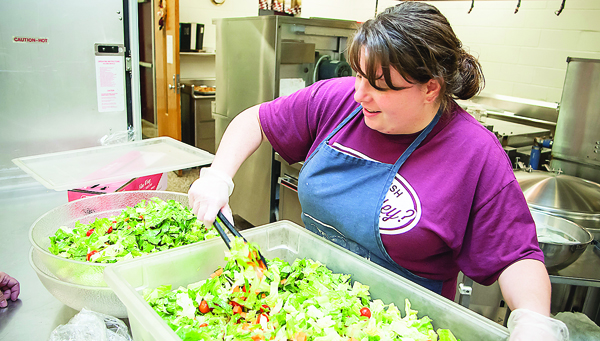School lunches… Seasoned with Love
Published 8:51 am Monday, October 13, 2014

Photos by Brandon Hicks
Christina Melton, left, and Faith Shell enjoy lunch together at Happy Valley Elementary School.
Love is the key ingredient when cooking for the children attending Carter County schools according to Marisa Potter.
Potter, director of food services for the school system, said that love goes into every meal the cafeteria staffs prepare.
“We are trying to do our best for the children, making sure everything we do is done with love,” Potter said.
Monday kicks off National School Lunch Week, a time to celebrate and appreciate the hard work by the men and women who make sure the community’s children receive a good, nutritious breakfast and lunch so they are better prepared to learn at school.
Potter said her staff works hard every day to feed the children and are a big part of the school meal program’s success.
“They just love the kids,” she said, adding passion is an important part of the job.
Many of the children form a bond with the cafeteria staff, Potter said. “They will just come in and tell them all kinds of things about what’s going on in school or at home,” she said.
This year, Potter revamped the menus for all of the county schools. She did surveys with the students to find out which foods they liked and which ones weren’t so popular. Potter said she took the students’ answers and worked within the federal nutrition guidelines to create a menu more pleasing to the children.
Federal regulations dictate many aspects of the school meals, Potter said. The guidelines dictate how many fruit and vegetable servings must be offered by the school each week and also require that every meal served to students must include at least one fruit or vegetable.
Potter said one of the keys to making the meal program successful is having options for the children to choose from. School meals include two choices of entreés as well as a variety of vegetables and fruits as side dishes.
The regulations also cover other nutritional requirements as well, Potter said. “The government is really big on everything being low sodium,” she said, adding the cafeterias have gone to using low sodium versions of some foods and have decreased the amount of salt used in the preparation of food.
“All of the stuff that is breaded – like chicken patties or chicken nuggets – is whole grain breading,” she said.

Photo by Brandon Hicks
Crystal Roark, a cook at Happy Valley Middle School, prepares a salad for lunch on Friday.
Potter said whenever possible, she purchases fruits and vegetables locally, which helps make sure those items are fresh. The schools also use cooking methods such as steaming for the vegetables, which she said not only helps preserve the food’s fresh taste but is also healthier for the students.
“I feel like we have helped them nutritionally,” she said.
Another key to success, according to Potter, is having the food fresh and hot when the children come through the lunch line.
“When I came they were cooking it all ahead and keeping it in warmers, but we’re not doing that now,” Potter said. “We cook in batches now. That way it’s fresh and hot when the children come in.”
Earlier this year, the school system opted into a federal program, called the Community Eligibility Program, which is allowing the school system to provide free school meals to all of the students in grades K-8 throughout the county. Since adopting the program the number of meals served by the schools has continued to rise, Potter said, adding she is pleased the system is able to provide meals to these children.
She said some studies have shown that children learn better when they have their nutritional needs met.
“I hope it is making a difference,” Potter said, adding she plans to meet with teachers and other school staff to see if they have noticed a difference in the children’s performance.
National School Lunch Week was created in 1962 by President John F. Kennedy and has been a celebration across the nation ever since.

Photo by Brandon Hicks
Marietta Hodges, a cook at Central Elementary, carries a tray of corn pups to the serving line. The little bite-sized corn dogs are a big hit with the children.





